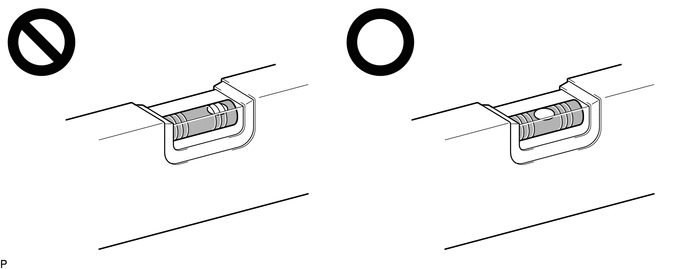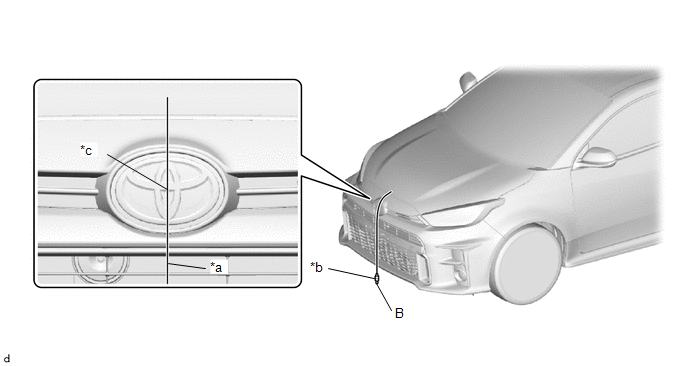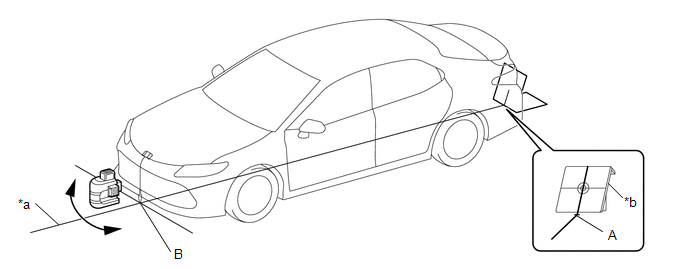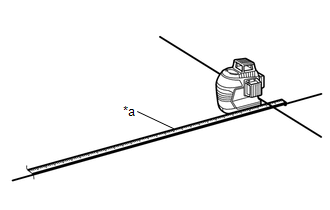Toyota Yaris: Millimeter Wave Radar Sensor / Target Adjustment(triangle Target)
TARGET ADJUSTMENT(TRIANGLE TARGET)
PROCEDURE
1. PREPARATION FOR MILLIMETER WAVE RADAR SENSOR ASSEMBLY ADJUSTMENT
(a) Park the vehicle on a level surface where the area in front of the vehicle shown in the illustration is free of metal objects.

| mostbet app *a | 5 m (16.4 ft.) |
| *b | 6 m (19.7 ft.) |
| *c | 4 m (13.1 ft.) |
| *d | 2 m (6.56 ft.) |
| *e | 3 m (9.84 ft.) |
| *f | 1.5 m (4.92 ft.) |
| *g | 2.5 m (8.20 ft.) |
 | Do not place any metal objects in this area |
 | Do not place metal objects with a height of more than 50 mm (1.97 in.) in this area |
HINT:
Metal objects with a height of 50 mm (1.97 in.) or less placed within the area shown in the illustration will not affect the adjustment.
(b) Check the levelness of the ground.
(1) Check the levelness of the ground at the 3 points shown in the illustration.

| *a | 3 m (9.84 ft.) |
 | Levelness Check Point |
(2) Place the level on each levelness check point and check that the air bubble of the level is centered.

(c) Adjust the tire inflation pressure to the specified pressure.
Click here

(d) Clean the front emblem or millimeter wave radar sensor assembly.
(e) Visually inspect the front of the vehicle.
HINT:
Confirm that there is no damage or deformation.
(f) Visually inspect the front bumper assembly, radiator grill and stays.
HINT:
Confirm that there is no damage or deformation.
2. MILLIMETER WAVE RADAR SENSOR ASSEMBLY VERTICALLY AND HORIZONTALLY
| (a) Adjust SST (reflector) height. (1) Adjust SST (reflector) so that the center of SST (reflector) is the same height as the millimeter wave radar sensor. HINT: Make sure to align the center of SST (reflector) with the millimeter wave radar sensor (the center of the emblem). Reference Value: 690 mm (2.26 ft.) SST: 09870-60000 09870-60010 SST: 09870-60040 |
|
(b) Hang a weight with a pointed tip from the center of the rear emblem, and mark the rear center point of the vehicle (point A) on the ground.

| *a | String | *b | Weight |
| *c | Center | - | - |
HINT:
Lightly flick the string with your fingers several times to confirm that the string is perpendicular to the ground.
(c) Hang a weight with a pointed tip from the center of the front emblem, and mark the front center point of the vehicle (point B) on the ground.

| *a | String | *b | Weight |
| *c | Center | - | - |
HINT:
Lightly flick the string with your fingers several times to confirm that the string is perpendicular to the ground.
(d) When using a laser line marker:
NOTICE:
Do not look directly into the laser beam.
| (1) Press the laser mode button on the laser line marker to activate the laser line emitters. |
|
| (2) Align the laser beam ground marking point (cross portion) with point B. |
|
(3) Align the center of the target panel with point A, and set the target panel so that it faces forward.

| *a | Center Line | *b | Target Panel |
(4) Adjust the position of the laser line marker so that the laser beam is aligned with the center line of the target panel.
| (5) Extend a tape measure at least 3000 mm (9.84 ft.) in length from point B, and set the tape measure in place. |
|
| (6) At a distance of 3000 mm (9.84 ft.) from point B, apply an approximately 200 mm (7.87 in.) piece of tape alongside the tape measure, and mark point C. |
|
(e) When not using a laser line marker:
(1) Using tape and a string, create a line that connects point B to point A and extends at least 3000 mm (9.84 ft.) beyond the front center point of the vehicle.

| *a | String | *b | Tape |
| *c | 3000 mm (9.84 ft.) | - | - |
HINT:
- Make sure the string is taut when securing it with tape.
- Lightly flick the string with your fingers several times to confirm that the string is aligned with point B.
(2) Mark point C (SST (reflector) placement position) at a position 3000 mm (9.84 ft.) from point B.
(3) Place SST (reflector) at point C.
(f) Front Beam Axis Adjustment:
NOTICE:
- Close all of the doors.
- Ensure that nobody enters the adjustment area during the adjustment.
- Do not move or shake the vehicle during adjustment (do not get in or out of the vehicle).
- Do not turn off the GTS or ignition switch.
- If the vehicle moves or is shaken during beam axis adjustment such as during strong winds or a door is opened or closed, perform the adjustment again.
(1) Connect the GTS to the DLC3.
(2) Turn the ignition switch to ON.
(3) Turn the GTS on.
(4) Enter the following menus: Body Electrical / Front Radar Sensor / Utility / Front Beam Axis Adjustment.
Body Electrical > Front Radar Sensor > Utility| Tester Display |
|---|
| Front Beam Axis Adjustment |
(5) Press "Next".
(6) Perform the adjustment according to the display on the GTS.
NOTICE:
If an error code is displayed, perform troubleshooting according to the following table, then perform the adjustment again.
| Error No. | Error Description | Cause of Error | Action to be Taken |
|---|---|---|---|
| 1 | No target abnormality |
| Place SST (reflector) in the correct position. (See page 2. MILLIMETER WAVE RADAR SENSOR ASSEMBLY VERTICALLY AND HORIZONTALLY (b) Place SST (reflector)) |
| Clean the front emblem or millimeter wave radar sensor assembly. | |||
| Check the installation condition of the front bumper assembly and radiator grill. | |||
| Remove any reflective objects. | ||
| Ensure that nobody enters the adjustment area during the adjustment. (See page 1. PREPARATION FOR MILLIMETER WAVE RADAR SENSOR ASSEMBLY ADJUSTMENT) | |||
| Place SST (reflector) in the correct position. (See page 2. MILLIMETER WAVE RADAR SENSOR ASSEMBLY VERTICALLY AND HORIZONTALLY (b)Place SST (reflector)) | ||
| Perform adjustment in an area with no wind. | |||
| 5 | Axis adjustment |
| Optical axis adjustment. (See page 2. MILLIMETER WAVE RADAR SENSOR ASSEMBLY VERTICALLY AND HORIZONTALLY (c) Front Beam Axis Adjustment) |
| 6 | Target angle abnormality |
| Place SST (reflector) in the correct position. (See page 2. MILLIMETER WAVE RADAR SENSOR ASSEMBLY VERTICALLY AND HORIZONTALLY (b)Place SST (reflector)) |
| Check the condition of the sensor, radiator grill and front bumper assembly. | |||
| 7 | Radar abnormality |
| Replace the millimeter wave radar sensor assembly. |
| 8 | Radar dirtiness |
| Clean the front emblem or millimeter wave radar sensor assembly. |
| 9 | Temperature abnormality |
| Wait until the temperature drops to the operable range (-30 to 50°C). |
| 10 | Voltage abnormality |
| Check the auxiliary battery voltage (specified condition: 10 to 16 V).
|
| 11 | External communication abnormality |
| Check the condition of the connectors and wire harness. |
| 12 | Radar axis aiming failure upward |
| Check the condition of the sensor, radiator grill and front bumper assembly. |
| Confirm road gradient. | |||
| 13 | Radar axis aiming failure downward |
| Check the condition of the sensor, radiator grill and front bumper assembly. |
| Confirm road gradient. | |||
| 14 | Vehicle speed abnormality |
| Ensure that the vehicle remains stationary. |
| 15 | Other |
| Re-do the Axis Adjustment |
| 16 | Time out |
|
|
| 17 | Target parameter abnormality |
| Perform beam axis adjustment again. |
| 18 | Vehicle information undefined |
|
|
(7) Press "Exit" to finish front beam axis adjustment.
(g) Front Beam Axis Misalignment Reading:
NOTICE:
- Close all of the doors.
- Do not move or shake the vehicle during adjustment (do not get in or out of the vehicle).
- Ensure that nobody enters the adjustment area during the adjustment.
- Do not turn off the GTS or ignition switch.
(1) Enter the following menus: Body Electrical / Front Radar Sensor / Utility / Front Beam Axis Misalignment Reading.
Body Electrical > Front Radar Sensor > Utility| Tester Display |
|---|
| Front Beam Axis Misalignment Reading |
(2) Press "Next".
(3) Perform the adjustment according to the display on the GTS.
Specified Condition:
| Vertical | -0.5 to 0.5 deg. |
| Horizontal | -0.5 to 0.5 deg. |
NOTICE:
If the result is not as specified, perform beam axis adjustment again.
(4) Turn the ignition switch off.
(5) Disconnect the GTS from the DLC3.
(h) After beam axis adjustment completes, clear the following system vehicle control history entries.
(1) Clear vehicle control history (Dynamic radar cruise control system).
Click here

(2) Clear vehicle control history (Lane Tracing Assist System).
Click here

(3) Clear vehicle control history (Front Radar Sensor system).
Click here

(4) Clear vehicle control history (Pre-collision system).
Click here

(5) Clear vehicle control history (Lighting system).
Click here

 Driving Adjustment
Driving Adjustment
DRIVING ADJUSTMENT CAUTION / NOTICE / HINT NOTICE:
Make sure to read Before Starting Driving Adjustment before proceeding with work.
Click here
Make sure to perform the transition to online axis alignment mode with the vehicle stopped...
 Target Adjustment(flat Surface Target)
Target Adjustment(flat Surface Target)
TARGET ADJUSTMENT(FLAT SURFACE TARGET) PROCEDURE 1. PREPARATION FOR MILLIMETER WAVE RADAR SENSOR ASSEMBLY ADJUSTMENT (a) Park the vehicle on a level surface where the area in front of the vehicle shown in the illustration is free of metal objects...
Other information:
Toyota Yaris XP210 (2020-2025) Reapir and Service Manual: On-vehicle Inspection
ON-VEHICLE INSPECTION CAUTION / NOTICE / HINT The necessary procedures (adjustment, calibration, initialization or registration) that must be performed after parts are removed and installed, or replaced when repairing air leaks in the intake system are shown below...
Toyota Yaris XP210 (2020-2025) Owner's Manual: Tire Labeling
Federal law requires tire manufacturers to place standardized information on the sidewall of all tires. This information identifies and describes the fundamental characteristics of the tire and also provides a tire identification number for safety standard certification and in case of a recall...
Categories
- Manuals Home
- Toyota Yaris Owners Manual
- Toyota Yaris Service Manual
- Removal
- Auto Lock/Unlock Function
- Immobilizer System
- New on site
- Most important about car
Front Seat Belt Pretensioners
The front seat belt pretensioners are designed to deploy in moderate or severe frontal, near frontal collisions.
In addition, the pretensioners operate when a side collision or a rollover accident is detected. The pretensioners operate differently depending on what types of air bags are equipped. For more details about the seat belt pretensioner operation, refer to the SRS Air Bag Deployment Criteria.






